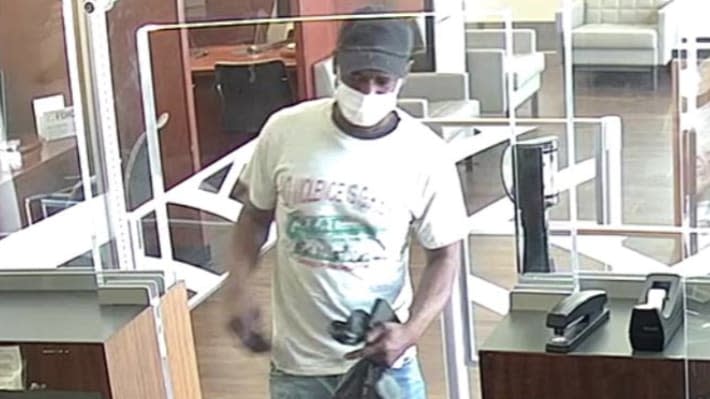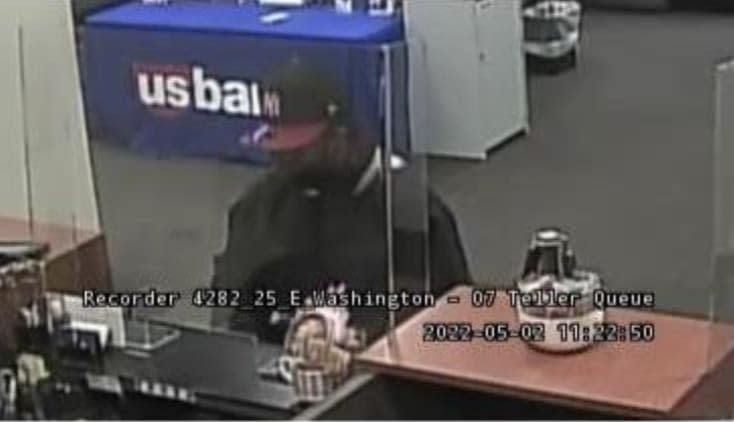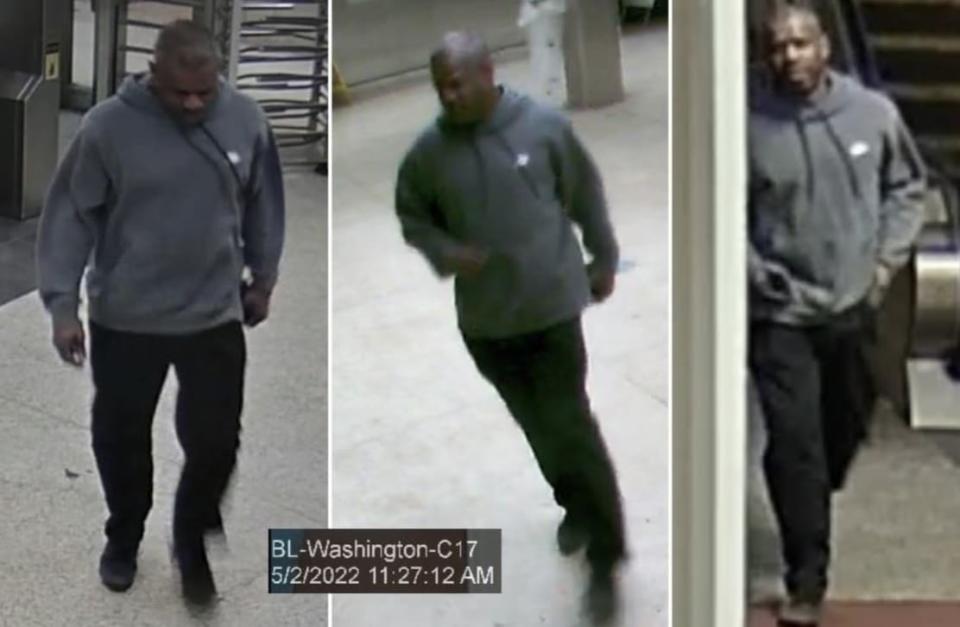Inside the Stringer Bell Bandit’s Bank Heist Spree

“Give me all the money in drawer Now! Hurry up.”
The handwritten demand on a crumpled piece of paper towel found squished inside Kenneth Anderson’s wallet, next to his ID and his Ventra card, would have seemed more innocuous if the FBI had found it on anyone else. But agents recognized it as the note used in at least some of the nine banks the 55-year-old allegedly robbed across downtown Chicago.
The note, prosecutors alleged in a search warrant application filed this week, was critical to Anderson’s long-practiced art of robbing a bank. Prosecutors allege that during a 56-day stint across Chicago’s “Loop,” Anderson strolled up to bank counters and quickly showed a bank teller his written demand.
If the teller was not fast enough, Anderson allegedly would verbally encourage the teller to work faster—but would never threaten any physical harm or brandish a weapon. After collecting at least $1,000 in cash, Anderson would walk out of the bank as quickly as possible before hopping on the closest CTA train to escape.
Prosecutors say that Anderson had robbing a bank down to a science because he had done it over a dozen times previously over the last 15 years in Chicago. Previously convicted of three heists in 2007, Anderson’s serial bank robbery spree in 2012 famously earned him a nickname from the FBI.
Because Anderson “often wore his glasses at the edge of his nose,” he was dubbed the ‘Stringer Bell Bandit,’ a reference to a character in the popular HBO television series, The Wire,” prosecutors said in his 2014 sentencing memo.

Idris Elba shot to fame playing Stringer Bell in “The Wire.”
While authorities have not officially charged Anderson in connection with the heists between May 2 and June 27, he was arrested by the FBI on South State Street on July 1. Since then, The Chicago Tribune reported, he has been ordered held without bond for allegedly violating the terms of his supervised release for his previous bank robbery conviction and is scheduled to have a hearing at the end of the month. Federal defenders for Anderson did not immediately respond to a request for comment.
But court documents reviewed by The Daily Beast provide details into Anderson’s criminal history. While Anderson has been convicted in five bank heists and one attempted robbery since 2006—he has been implicated in about a dozen other heists with similar MOs.
In each of the crime sprees, prosecutors have noted Anderson’s skill of using non-violent methods to systematically hold up banks in a 1.5 mile radius in Chicago, often hitting the same banks in a matter of days. Each time, Anderson never steals more than $3,000 and is often seen wearing a hat for a sports team.

Kenneth Anderson during his one of his alleged bank robberies.
In past court documents, Anderson has attributed his serial crimes that have landed him in jail for over 180 months to having little family support, no consistent income, and a drug addiction that began when he was a teenager.
“I did the crimes for purposes of survival,” Anderson told a clinical neuropsychologist after he landed back in jail in 2012, his federal defense lawyers wrote a 2014 sentencing position paper ahead of his sentencing.
Two former FBI agents told The Daily Beast that re-offending in bank robberies is common—especially if drugs and financial struggles are stressors. Nancy Savage, who served in the FBI for over 30 years in several metropolitan cities, stressed that “bank robbers almost always get caught.”
“We considered bank robbery cases great training cases as there is so much ready evidence—fingerprints, photos, notes, handwriting, sometimes DNA, witnesses, getaway cars,” she told The Daily Beast. “They commit a robbery, in front of people, in daylight, with cameras trained on them. They tend to be desperate. My experience is often they are addicted to drugs or gambling.”
Another FBI official, who used to work in Chicago and asked to remain anonymous for professional reasons, added that there is habit and hubris involved in the methodology of a serial bank robber, who he says often treat their crime “as an art.”
“We used to have a saying back in the day, ‘Bank robbers rob banks.’ It is very often seen that these guys view themselves as specialists,” the official added. “Once they hone the skill, they won’t stop.”

The note that Kenneth Anderson would allegedly hand over to bank tellers.
For Anderson, his spiral into criminality began as a teenager.
“Anderson believes that his biggest mistakes have come from his use of drugs,” his lawyers wrote in their 2014 position paper, noting that he said he started smoking weed in his teens before eventually trying cocaine and other drugs in his adulthood. “According to Anderson, his drug use led to his criminal activity because he did not think carefully about his actions and their consequences.”
In his 2013 plea agreement, prosecutors noted that Anderson’s lengthy criminal record began in October 1984 when he was sentenced to one day in prison and a $275 fine after being convicted of theft. Details of that theft, however, were not immediately available.
Almost two decades later, Anderson was sentenced on May 21, 2003, to nine months in prison for bail jumping and an additional three months for disorderly conduct for offices in Wisconsin. Two days later, he was sentenced in Wisconsin to one month in jail for violating a restraining order.
After his release, Anderson was convicted in April 2007 for three separate bank robberies and sentenced to 78 months. He was suspected of committing several more.
In 2012, after serving his time, Anderson began his three-year probation of service release. Once he was released from his halfway house, however, Anderson “was unable to go back to live with his mother because her deteriorating health required her transfer to a nursing home,” his lawyers said in his 2014 sentencing position paper.
“With nowhere else to go, Anderson sought the help of his cousin, who agreed to let him stay in the basement of the home his cousin shared with her husband and teenage daughter,” the position paper reads, adding that he continued his education studying electronic engineering technology at DeVry University which he began while still at the halfway house.
“He was doing well, made it onto the Dean’s list, and was on track to graduate in 2014,” the paper added.
But just six days after Anderson had settled into his cousin’s house, his mother passed away. Devastated by losing his only “real source of support in his family,” the paper noted that his father and half-sister had passed away years prior and his brother “was not in a position to provide support when dealing with his own disability.”
“Anderson did the best he could to deal with the loss of his mother, but felt increasingly alone,” his lawyers added in the 2014 sentencing position paper.
Things seemingly got worse for Anderson in September 2012, when he “accidentally walked in on his cousin’s daughter while she was taking a shower” at the house’s basement. The sentencing position paper said that Anderson insisted he did not hear the teen girl enter the bathroom and “was startled by her presence, especially because he/she would already be at school.”
But because of the Chicago teachers’ strike, the teenage girl was home—spurring a situation that prompted his cousin’s husband to give Anderson “six days to leave their home.”
“Anderson had no family or friends who could help him, and ended up homeless,” the paper stated. “According to Anderson, he found himself in a bind, couldn’t think clearly about a way out, and thought of the only way he knew from his immediate past to make money for survival.”

Kenneth Anderson in a mug shot.
That “bind,” he claims, is what prompted him to go into the PNC Bank on Oct. 23, 2012.
“On at least five separate occasions over a five-week span in the fall of 2012, the defendant walked into four different banks, all located in the ‘Loop’ in Chicago, and robbed them,” prosecutors wrote in their 2014 sentencing memo, adding that during the heist Anderson exhibited the same pattern.
“Considering that the defendant arrived at each bank with a handwritten note in hand, all five of the defendant’s bank robberies were premeditated and inherently dangerous,” prosecutors added.
In a 2013 plea agreement where he pleaded guilty to two heists and entered a third bank with an intent to rob, Anderson admitted to stealing $3,813 at PNC after displaying a handwritten note to the teller with the words “50’s, 100’s, No Bait.” As the teller collected the money for Anderson, the agreement states that he yelled the words “Let’s move it along,” I don’t have much time.”
“Bitch, you know what time it is,” Anderson allegedly told the teller, prosecutors said in a 2014 sentencing memo.
The FBI official noted to The Daily Beast that most banks only give tellers a “pretty finite amount of money for their drawer,” meaning that quick heists will never amount to a big pay day.
“By and large, if you go to a single teller, the likelihood they have a lot of money is pretty darn low,” the FBI official added. “Most tellers appreciate this, that if they are handing out a ridiculous amount of money there would be questions.”
On Nov. 2, 2012, Anderson hit the Fifth Third Bank—where he stole approximately $2,331 in his similar, non-violent pattern. Prosecutors noted in a criminal complaint for the 2012 spree, the teller initially gave Anderson some money after he slipped him a piece of paper that read: “5 or 8 thousand dollars.” After demanding “more than that, Anderson left in his White Sox Jacket and black skull cap.
“The teller further described the bank robber’s face as being dirty and having acne bumps, with a beard,” the complaint noted.
As federal authorities began to investigate the robbery, the December 2012 complaint notes, agents noticed similarities between the robber and Anderson—who had been already dubbed “the Stringer Bell Bandit'' on the website www.bandittrackerchicago.com.
The plea agreement also detailed his other alleged crimes, including a Nov. 8, 2012, robbery at a Citibank, where he stole $1,401 after handing the teller “a note containing, in part, a dollar sign and the number ‘50,’ along with other writing.”
In Anderson’s sentencing position paper, his lawyers state that after the robbery a teller heard him say “Thank you” as he took the money and left the bank.
Anderson then allegedly hit another Citibank just days later, on Nov. 26, 2012. Telling the teller they have “less than 20 seconds” in a handwritten note, police say Anderson stole $1,757 from the teller’s drawer.
“Look, you have less than 20 seconds to give me all your money,” he told the scared teller at one point during the incident. Anderson’s sentencing position paper said that after taking the money and the note, he said; “Thank you, Miss, have a nice day” before leaving the bank.
In the sentencing memo, prosecutors also noted that Anderson “clearly demonstrated a recognition and affirmative acceptance of personal responsibility for his criminal conduct.” They also noted that after his arrest, Anderson admitted to at least six other robberies.
“Defendant is a serial bank robber, and it appears that the only proven method of stopping him from committing future bank robberies is imprisonment,” sentencing memo states. “Similar to his three convicted bank robberies in a 60-day span in downtown Chicago in the fall of 2006, the defendant proceeded to engage in a bank-robbing binge in the fall of 2012, by which he robbed ten banks within two months, all in close proximity to each other.”
On Nov. 30, 2012, Chicago Police Department officers responded to a “flash” dispatch message alerting them that Anderson had just entered the same Fifth Third Bank location he had robbed earlier that month. Officers apprehended Anderson, who had a handwritten note in his left front pocket with the words: “Hand over all the money now you have 20 seconds.”
During a police interview, Anderson admitted he had committed a string of robberies over the course of several months that were attributed to the “Stringer Bell Bandit.”
“Yes, these are all me,” Anderson said after reviewing a map of the robberies, the complaint states.
In arguing for Anderson to have a lighter sentence after his 2012 stint, his lawyers stressed that he only re-offended because he “became discouraged and reacted irrationally instead of thinking through more appropriate possible solutions” after losing his family and home.
“It seems clear, then, that the amount of time Anderson actually serves in custody may not have a tremendous influence on whether Anderson reoffends when released,” the paper notes. “Practically speaking, the amount of time Anderson spends in prison for these crimes will not change the fact that Anderson will again be with little family support. And the time he spends behind bars will not influence his ability to find a stable place to live so he can pursue his educational and vocational goals and ultimately become self-sufficient.”
His team also asked a judge to impose a condition that would force Anderson to participate in a mental health treatment program, substance abuse program, and report to his probation officer more frequently than previously required.
“If this kind of structure and support is provided for Anderson while on supervised release, he will be much less likely to turn to crime as a means of survival. And what that will mean is a lesser need to incapacitate Anderson now to protect the public,” his lawyers said in the sentencing paper.
“Anderson did not use a weapon, did not mention a weapon, and did not infer in any way that he had a weapon” the sentencing paper added. “He did not use any threatening language with the tellers, and even said ‘thank you’ and ‘have a nice day’ to two of the tellers. And Anderson did not use any form of physical aggression or violence.”
The bank robber’s lawyers also noted in the 2014 document that while their client had no history of diagnosed mental illness at the time, he was evaluated by several psychologists since his first bank robbery case in 2006. One of those evaluations was performed by Dr. Robert Heilbronner, a clinical neuropsychologist who “concluded that Anderson’s current offenses, for which Anderson appears to feel appropriate remorse, were committed ‘because he saw no other way to manage the situation he was in.’”
Heilbronner told The Daily Beast that while documentation notes he did review Anderson, he does not remember him.

Kenneth Anderson seen on CCTV.
Anderson was starting his latest attempt to restart his life under supervised release when prosecutors allege he slipped back into his life of crime.
In the application and affidavit for a search warrant filed on Tuesday, authorities say that on May 18 a bench warrant was issued for his arrest “based on his violation on the conditions of his release.”
The bench warrant was issued after Anderson had allegedly already stolen $1,339 on May 2 from US Bank, after approaching a teller who asked him if he wanted to “make a withdrawal.”
“Read the note,” Anderson allegedly said after sliding over a hand piece of paper that read: “Give me all the money in your drawer and hurry your ass up!”
After exiting the bank, security footage shows Anderson wearing a black New York Yankees cap with a red brim and black mask during the heist. The affidavit notes that the baseball hat was later found behind a dumpster near the bank. Following his steps after leaving the bank, FBI agents were quickly able to identify the robber as Anderson—and learned that he had hopped onto the FTA train to make his escape.
On May 23, Anderson allegedly hit Huntington Bank—once again slipping a bank teller a “crumpled note that appeared to be written in pencil.”
“The robber said something to the effect of “give me all the money now, just give it,’” the affidavit states, noting that the teller “gave the robber many small bills and a dye pack” before he ran out the door and used the CTA train to make his grand escape.
Days later, on June 27, Anderson robbed a Bank of America. This time, Anderson allegedly approached the middle teller window and “appeared to be nervous.”
Initially mumbling his demand, the affidavit states that Anderson “spoke with a light stutter” that the teller did not initially hear. Then, Anderson allegedly pointed at his “phone in a brown flip case and a plastic bag in his hands” to the teller.
“The robber then pushed a note under the glass, but when [the teller] went to grab it, the robber pulled it back,” the affidavit states, adding that the teller “could not read the note, but saw it was on white paper with black writing.”
“The robber pulled his mask down and [the teller] understood him to be saying words to the effect of, “Give me all the cash. Right now,’” the affidavit started. “[The teller] initially froze as a coworker was not behind the teller line glass. The robber kept repeating to give him all the cash right now and kept saying it louder.”
After handing him the money, Anderson folded the bills into his front jean pocket and exited the bank in his blue hospital mask.
Authorities believe that Anderson also hit up six additional banks during his spree, each time fleeing the scene on the CTA rail. His consistent escape method, the affidavit notes, eventually led to his downfall as it allowed investigators to track his whereabouts. During his July 1 arrest, Anderson had his CTA rail card, an empty plastic bag, his wallet, the paper towel demand letter, and a cloth mask.
For Savage, who spent her FBI career in the criminal division, Anderson’s methodology is common in the world of bank robbers. She noted that several of these offenders “don’t usually stop on their own” and usually rely on law enforcement to catch them.
“I have also seen a robber get out and rob again and wait to be caught as he had become institutionalized and just wanted to go back to jail,” she added. “The outside world was too uncomfortable for him.”
Get the Daily Beast's biggest scoops and scandals delivered right to your inbox. Sign up now.
Stay informed and gain unlimited access to the Daily Beast's unmatched reporting. Subscribe now.

